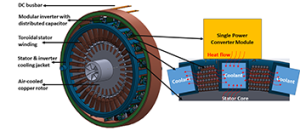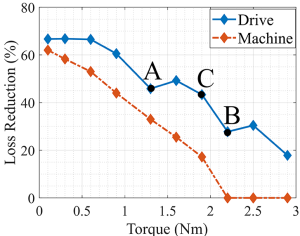Variable-Pole Induction Machines Drives for Electric Vehicles
PhD Student Elie Libbos with Advisor A. Banerjee
Induction machines (IM) are an attractive permanent magnet-free solution for electric vehicle drivetrains with distinct advantages such as low cost, reliability, and capability to withstand high short-term overload. Induction machines can operate at a much higher temperature when compared to permanent-magnet-based machines without the risk of demagnetization. Our proposed system consists of a toroidally-wound variable-pole IM (VPIM) drive with an integrated modular 18-phase converter, as shown in Fig. 1. The toroidal winding configuration provides advantages for thermal performance over conventional distributed windings due to increased winding copper surface area without reducing the slot-fill factor, allowing for a higher stator density. Our developed variable-pole induction motor has an estimated power density of 40 kW/L. Our proposed power electronics and machine co-design framework shows system-level efficiency improvement, especially at partial torque and high speed as shown in Fig. 1(b), machine volume and loss reduction, 62% dc link capacitance reduction, and improvement in thermal performance compared to a conventional three-leg fixed-pole drive. Currently, we are working on integrating the thermal and electromagnetic models and pole-transition transients.
Figure 2-a shows our experimental setup. An 18-leg GaN-based inverter is used to drive a 36-slot toroidally wound IM with access to each of its individual slots. This setup allows us to reconfigure the IM to various pole counts (2-, 4-, 6-poles). A Zedboard FPGA is used to control the converter. Figure 2-b shows that the 18-leg drive reduces drives losses are significantly reduced, especially at partial load due to variable-pole operation. These thermal improvements are mainly achieved because of the higher efficiency of the 18-leg converter and better loss-psharing among more phases.

Figure 3. Experimental setup with the 36-slot toroidally wound IM driven by two 9-phase GaN-based inverter modules.


